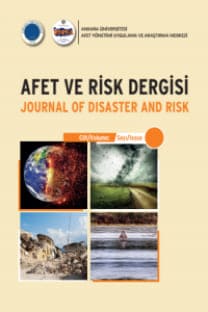İlköğretim Üçüncü Sınıf Öğrencilerinin Su Ayak İzi Kavramlarına Yaklaşımlarının İncelenmesi
Su Ayak İzi, Gizli Su Kullanımı, Temiz Su Kaynakları, Kuraklık, Su Tasarrufu, Çevre Eğitimi
Investigation of Primary School Third Grade Students' Approaches to Water Footprint Concepts
Water Footprint, İnvisible Water Usage, Clear Water Resources, Drought, Water Saving, Environmental Education,
___
- Assadourian, E. (2010). Transforming cultures: From consumerism to sustainability. Journal of Macromarketing, 30(2), 186-191. https://doi.org/10.1177/0276146710361932
- Bos, W., & Tarnai, C. (1999). Content analysis in empirical social research. International journal of educational research, 31(8), 659-671. https://doi.org/10.1016/S0883-0355(99)00032-4
- Bozyiğit, R., & Tapur, T. (2009). Konya Ovası ve çevresinde yeraltı sularının obruk oluşumlarına etkisi. Selçuk Üniversitesi Sosyal Bilimler Enstitüsü Dergisi, (21), 137-155. Chellaney, B. (2013). Water, peace, and war: Confronting the global water crisis. Rowman & Littlefield.
- Çakır Yıldırım, B., & Karaarslan Semiz, G. (2019). Future teachers’ sustainable water consumption behavior: A test of the value-belief-norm theory. Sustainability, 11(6), 1558.
- Davis, J. (2010). Early childhood education for sustainability: Why it matters, what it is, and how whole centre action research and systems thinking can help. Journal of Action Research Today in Early Childhood, 35-44.
- Hatami, H. (2013). Importance of water and water-borne diseases: on the occasion of the world water day. International journal of preventive medicine, 4(3), 243.
- Hedefalk, M., Almqvist, J., & Östman, L. (2015). Education for sustainable development in early childhood education: A review of the research literature. Environmental Education Research, 21(7), 975-990. https://doi.org/10.1080/13504622.2014.971716
- Hoekstra, A. Y., Chapagain, A. K., Aldaya, M. M., & Mekonnen, M. M. (2009). Water footprint manual. Enschede, the Netherlands: Water footprint network.
- Hoekstra, A. Y., & Mekonnen, M. M. (2012). The water footprint of humanity. Proceedings of the national academy of sciences, 109(9), 3232-3237. https://doi.org/10.1073/pnas.1109936109
- Merriam, S. B. (2009). Qualitative research: A guide to design and implementation. San Francisco, CA: Jossey-Bass.
- Milanovic, B. (2016). Global inequality. Harvard University Press.
- Milli Eğitim Bakanlığı. (25.05.2022 ). Hayat bilgisi dersi öğretim programı (ilkokul 1, 2 ve 3. sınıflar). http://mufredat.meb.gov.tr/Programlar.aspx
- Milli Eğitim Bakanlığı. (25.05.2022 ). Fen bilimleri dersi öğretim programı (ilkokul 1, 2 ve 3. sınıflar). http://mufredat.meb.gov.tr/Programlar.aspx
- Roser, M., & Ortiz-Ospina, E. (2017). Global rise of education. Our World in Data.
- Kaya, H. E., & Susan, A. T. (2020). Sürdürülebilir bir kentleşme yaklaşımı olarak, ekolojik planlama ve eko-kentler. İdealkent, 11(30), 909-937.
- Koçak, A., & Özgür, A. R. U. N. (2006). İçerik analizi çalışmalarında örneklem sorunu. Selçuk İletişim, 4(3), 21-28.
- Krippendorff, K. (2004). Reliability in content analysis: Some common misconceptions and recommendations. Human communication research, 30(3), 411-433. https://doi.org/10.1111/j.1468-2958.2004.tb00738.x
- Krippendorff, K. (2018). Content analysis: An introduction to its methodology. Sage publications. Lutz, W., Butz, W. P., & Samir, K. E. (Eds.). (2017). World population & human capital in the twenty-first century: An overview.
- Mays, L. W., Koutsoyiannis, D., & Angelakis, A. N. (2007). A brief history of urban water supply in antiquity. Water Science and Technology: Water Supply, 7(1), 1-12.
- Neuendorf, K. A. (2002). The content analysis guidebook. Thousand Oaks, CA: Sage. San, İ. (2021). Çocuk ve sanat. Yeni İnsan Yayınevi.
- Seto, K. C., Sánchez-Rodríguez, R., & Fragkias, M. (2010). The new geography of contemporary urbanization and the environment. Annual review of environment and resources, 35(1), 167-194.
- Sobel, D. (1999). Beyond Ecophobia: Reclaiming the Heart in Nature Education. Nature Study, 49, 4-12.
- United Nations Children’s Fund (UNICEF) (2020). For Every Child, Reimagine. UNICEF Annual Report 2019. New York.
- United Nations Framework Convention on Climate Change (UNFCCC) (2009). Guidance on the implementation of Article 6 of the Kyoto Protocol. https://unfccc.int/documents/6030(Son Erişim: 22.012.20121)
- Ünalan, H. T. (2016). Çocukta sanat eğitimi ve yaratıcılık. Anadolu Üniversitesi yayınları, Eskişehir.
- Yavuzer, H., (2003). Resimleriyle Çocuk, Remzi Kitapevi: İstanbul.
- Yayın Aralığı: Yılda 4 Sayı
- Başlangıç: 2018
- Yayıncı: Ankara Üniversitesi
24 Ocak 2020 Sivrice Depremi'nin (Doğu Anadolu Fayı) Etkilerinin Genel Değerlendirmesi, Türkiye
Karmaşık Bir Sosyo-Ekolojik Afet Olarak Göç ve Göç Araştırmalarında CBS
Çağla Melisa KAYA, Besime YÜCEL
Twitter Verisi İle Doğal Afet Müdahale Süreci İçin Karar Destek Uygulaması
AFAD Çalışanlarının İşe İlişkin Duyuşsal İyilik Algısı
Gülşah AYVAZOĞLU, Mustafa ÇEKİÇ, Seda UZUNALİ
Özge ÜNAL, Elvan KİREMİTÇİ CANIÖZ
Şeyma CEYLAN DEMİREL, Kemal Özgür HASTAOĞLU
Deprem Yaşayan Bireylerin Risk Algısı, Korku ve Hazırbulunuşluklarının İncelenmesi
Tuba GÜN ÇINĞI, Çağdaş Ümit YAZGAN
Türkiye’de Yapılan Kuraklık Analiz Çalışmaları Üzerine Bir Derleme
Yasemin DENİZ ÖZTÜRK, Ramazan ÜNLÜ
Yüksek Binaların Tahliye Etkinliğinin İncelenmesi: Gaziantep Ek Adliye Binası Örneği
Abdurrahman Yağmur TOPRAKLI, Muhsin Selçuk SATIR
Güvenlik ve Acil Durum Koordinasyon Merkezi (GAMER) ve Yapay Zekânın Afetlerde Uygulanabilirliği
